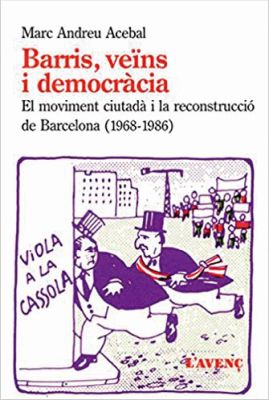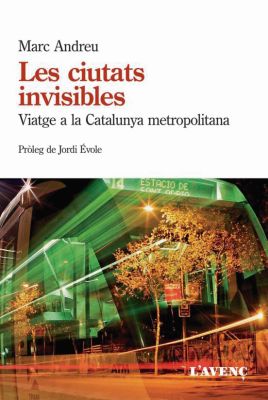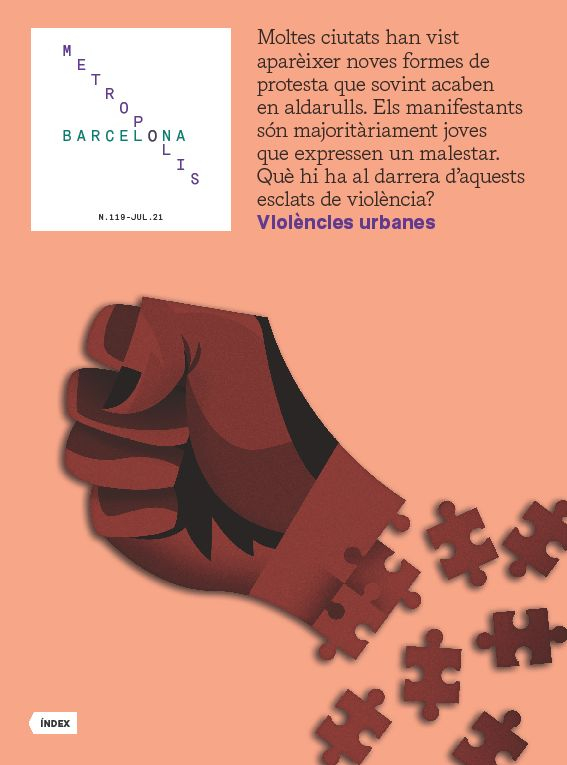Behind Barcelona’s barricades
- Dossier
- Sep 21
- 14 mins

Does the burning of rubbish bins as a form of protest on the streets of Barcelona correspond to flames of social revolt that evoke the spirit of the Rose of Fire? Or, on the contrary, do they spark nihilism against numerous crises and are they a showcase for a narcissism ignited on social networks but unlike the collective tradition of some peaceful social and barricade movements? The answer cannot ignore the examples of a contemporary history built by people’s coups in a city that is both bourgeois and revolutionary.
One of the photographs discovered in the “red box” of the photojournalist Antoni Campañà – with a recent exhibition at the MNAC [Catalan National Art Museum] and a wonderful book of images on the Spanish Civil War – portrays a group of children with their fists raised behind a toy barricade, on the street Carrer de la Diputació, in August 1936.[1] For the Barcelona that has featured in the news lately on account of the burning of bins and the clashes of young people with the police in protest at the imprisonment of rapper Pablo Hasél or, in autumn 2019, against the sentence of the trial surrounding the Catalan independence movement, Campañà’s photograph is helpful. It gives cause for reflection on the roots and causes of urban violence, with a certain revolutionary infantilism included, in a city that is also an exponent of demonstrations and social movements of great political maturity or of childish naivety but not necessarily violent in nature.
In fact, some of these demonstrations, social movements or urban revolts waved the flag of pacifism or antimilitarism. That does not certify anything, as evidenced by the violence of the Revolt of the Quintas [Conscripts] in the Gràcia neighbourhood, in 1870, or the Tragic Week of 1909. But in more recent history – and without going back to 1980, 1990 and 2000, decades of movements against NATO, of conscientious objection and insubordination, and of No to the war –, it can be concluded that both the movement of the “indignant”, which filled the squares on 15-M [15 May 2011], and the sweeping sovereignty movement of the last decade have been examples of civility. It is a true cliché that hundreds of thousands of people have demonstrated without throwing a single piece of paper on the ground. It is also true that during this intense period of movements – from the evacuation of Plaça de Catalunya, on 27 May 2011, to the quashing of the vote on independence, on 1 October 2017, and in neighbourhood actions against evictions –, when there has been violence, it has not usually been instigated by the protesters, but by the police. And that without delving into structural violence.
That does not mean that the city is, by definition and everywhere, synonymous with social and political conflict, riots and barricades. Just like Barcelona, in particular, is a benchmark as a city of peace, without fear. It was obvious in the citizen response to the jihadist attacks of August 2017, as had already been made evident in the major demonstrations of 1987 against the ETA attack on Hipercor and in 2000 against the murder of Ernest Lluch. These two sides of Barcelona, the city of peace and the city of barricades, like its qualifiers bourgeois and revolutionary at the same time, are not recent.[2] Built by people’s coups, contemporary history is full of examples that help to contextualise and afford complexity and solidity of analysis to a reality that can be hidden or distorted by short memory, limited knowledge in social sciences and the servitudes of liquid society and communicative immediacy.
Barcelona is a city that, when lately it experienced porn riot incidents broadcast on television and social networks, spilled over with the notion of the society of the spectacle, a term coined in the sixties by Guy Debord. Since history lends character to any society, social and collective memory reasons or community psychology cannot be underestimated against the backdrop of the burning of bins in Barcelona. Admittedly, the specific formula of urban protest is not new. However, although in the anthropology of urban space the ritual component of protests that often repeat scenarios and typology is studied, new elements emerge from the comparative historical and political analysis of recent episodes. There is a nihilism unlike the Barcelona tradition that cannot be dismissed by appealing to the manipulated cliché of the Italian anarchist conspiracy (incidentally, a constant with a historical substrate in the 19th century Orsini bombs and the Liceu bombing of 1893). And there is also a glimpse of new elements of individualistic narcissism, magnified by social networks, which do not fit into the collective tradition of sociopolitical activism in Barcelona, whatever ideological sign it may be. That is why the mystification of the barricade can be well discerned.
Without resorting to either the cliché of the Rose of Fire or the mythologised resistant Barcelona of 1714 or revolutionary Barcelona of 1936, many examples are testament to the unrest in the streets of the Catalan capital. In an 1873 memoir on the social upheaval in Spain, Friedrich Engels wrote that in Barcelona there were “more barricade fights than in any other city in the world”. A long century later, on 25 March 2003, a former president of the United States, George Bush Sr., referring to the major demonstration of No to the war held three days earlier on Passeig de Gràcia, declared: “No one can allow their politics to be decided by the number of people who demonstrate in Barcelona”.[3]
[1] Campañà, Antoni. La capsa vermella [The Red Box], Comanegra, 2019. The book’s edition is by Plàcid Garcia-Planas, Arnau Gonzàlez Vilalta and David Ramos, and the cited photograph is reproduced on page 76. Garcia-Planas and Gonzàlez Vilalta are curators, along with Toni Monné and Roser Cambray, of the exhibition La guerra infinita. Antoni Campañà [The Infinite War. Antoni Campañà], scheduled at the MNAC from 19 March to 18 July 2021.
[2] Two good informative works that encapsulate and reflect this spirit are: Huertas, Josep Maria, and Fabre, Jaume. Burgesa i revolucionària. La Barcelona del segle XX [Bourgeois and Revolutionary. The Barcelona of the 20th Century], Flor del Vent, 2000. And, in a more visual format: Adam, Roger; Antebi, Andrés, and González, Pablo. Cops de gent. Barcelona 1890-2014. Crònica gràfica de les mobilitzacions ciutadanes [People’s Coups. Barcelona 1890-2014. Graphic Chronicle of Citizen Mobilisations], Barcelona City Council, 2016.
[3] These references and an approach to the nature of Barcelona, as defined by Josep Fontana, as a historical subject with its own personality and conducive to promoting change, uniquely through the action of social movements can be found and further explored in: Andreu, Marc. Barris, veïns i democràcia. El moviment ciutadà i la reconstrucció de Barcelona (1968-1986) [Neighbourhoods, Neighbours and Democracy. The Citizen Movement and the Reconstruction of Barcelona (1968-1986)], L’Avenç, 2015.
Oliveres-type social leaders did not act out of ego or individualism, but supported by collective moral authority and accumulated democratic capital.
At the beginning of the 21st century, with the alter-globalist movement in the making, those brandishing placards against the Europe of the capital and the war in mass demonstrations in the centre of Barcelona were the deceased Arcadi Oliveres and other men and women of his generation. They had a solid socio-political, pacifist and anti-capitalist background, not so much because of academic training or partisan activism as because of the baggage of years of Christian, union, neighbourhood and internationalist militancy. They were mature people capable both of accompanying a cross-cutting but eminently youthful and anti-system protest and of negotiating margins or agreeing to disagreements with the governing authorities: the Socialist city council, Jordi Pujol’s Generalitat Government of Catalonia and José María Aznar’s Spanish Government. Although they knew they were reference points, Oliveres-type social leaders did not act out of ego or individualism, but supported by collective moral authority and the democratic capital accumulated by bodies such as Justícia i Pau [Justice and Peace], the FAVB [Federation of Neighbourhood Associations of Barcelona] and the Federació Catalana d’ONG [Catalan Federation of NGOs]. In fact, they were connections between worlds as far apart as the squatter movement and the unionism of the CCOO [Trade Union Confederation of Workers’ Commissions] and UGT [General Union of Workers], the usual left and the incipient pro-independence movement, illegal immigrants and Erasmus students.
The Barcelona where rubbish bins are burned today has nothing to do with the city that Engels placed in 1873 at the top of the ranking of barricade fights.
Alter-globalist marches like the one on 15 March 2002, with the EU summit in Barcelona, ended in violent incidents, charges and repression in the streets. Provocateurs among the protesters and, above all, police infiltrators were blamed for this. If that day did not end tragically, it was because the president of the FAVB, Manel Andreu, and the president of the Federació Catalana d’ONG, Gabriela Serra, at the helm of the convening platform, negotiated with the Government Delegation, in situ and between anti-riot raids and infiltrated agents, so the police did not show up at the Manu Chao concert that, in Montjuïc, concluded the protest. One year later, in another concert for peace, at the height of the war in Iraq and only five days after Bush criticised the No to the war rally in Barcelona, Manuel Vázquez Montalbán said in front of 30,000 people: “There are lots of us, we are right, let’s hold onto the power of the word. Remember that Espriu told us that a persecuted language can survive when it takes refuge in things, that is, in reality”.
In 2019, the actors and the coordinates were different. And the reality of Catalonia, Barcelona and the social movements, too. During the long pro-sovereignty process that began in 2010, it was seen that the ANC [Catalan National Assembly] and Òmnium were moving masses like never before in Europe, but they encouraged cognitive dissonance with reality and did not act in a cross-cutting manner, no matter how many appeals they made to the spirit of a single people and the shared struggles. And when the exemplary pro-independence pacifism blew up, after the imprisonment and sentencing of the leaders of the procés [the name by which the media have referred to the trial against the Catalan separatist leaders], neither the ANC and Òmnium nor the ruling pro-independence movement managed to measure up and politically channel the outrage. Or the enigmatic and original Democratic Tsunami, a virtual and semi-clandestine platform set up ex professo to coordinate the response to the sentence, which fizzled out on the way from the occupation of Prat airport to the battle in Urquinaona square.
The CDR did encourage the urban pro-independence upheaval in the autumn of 2019, but they were not able to politically lead what ended in the simple nihilism of burning rubbish bins. Those flames were rekindled, in February 2021 and in the throes of all the tension triggered by the pandemic, due to the imprisonment of rapper Pablo Hasél. But the latest incident of urban revolt in Barcelona, with aftershocks in other Catalan and Spanish towns, already took place without any known political direction. And even, sectors of the pro-independence left and autonomous groups endeavoured to steer the protest with the hashtag “fins que caiguin” [until they fall] and redirect it with the manifesto Per la majoria [for the majority] (signed by 250 bodies, but without the cross-cutting nature of other initiatives), which was presented on 13 March, in the Tres Xemeneies park, still with the support of Arcadi Oliveres.
 © Nicolás Aznárez
© Nicolás AznárezSpeeches at that event (the philosopher Marina Garcés and the General Secretary of the CGT [General Confederation of Labour], Ermengol Gassiot, among others) and the iconography of the poster design and communication through social networks of this new urban revolt, like in some media, sought to connect today’s Barcelona with the mystical Rose of Fire. “Recognising that the conflict exists makes us be alive, makes us a tool for struggle and enables us to change it. And we see that in opposition to fascism, in the flames, in the barricades and in the broken ATMs, which are also our collective action”, said Gassiot, amidst applause, after referring to the Canadenca strike of 1919 and the Paris Commune of 1871.
But the Barcelona where rubbish bins are burned today has nothing to do with the city that Engels placed in 1873 at the top of the ranking of barricade fights (and which was also the city of the hearts of Clavé, where music was another socialisation factor for the working class). Despite ruling the Communes, Barcelona is not the Paris Commune either (by the way, it is surprising that it was relegated by Barcelona in Engels’ ranking; even more so when Karl Marx reviewed the intense barricade story written by Prosper-Olivier Lissagaray).[1] In the 150 years of the Paris Commune, the historian Roberto Ceamanos, who has studied it in depth, states that “the barricade, a symbol of popular resistance, reached its golden age in the episode of the Commune.”[2] This academically reaffirms a conclusion already reached, based on her own experience, by the Russian journalist and communist Larisa Reisner, in 1923, in Hamburgo en las barricadas [Hamburg at the Barricades]: “The old and romantic barricade is long a thing of the past. Today the fight is different”.[3] Even so, the mystique of the barricades survives in Barcelona because of July 1936 and thanks to foreign authors such as the historian Chris Ealham[4] or the testimonies of George Orwell, Mary Low, Hans Erich Kaminski and Axel Österberg, who indeed wrote Tras las barricadas de Barcelona [Behind Barcelona’s Barricades].[5]
Historiography long ago resolved the categorisation of uprisings and protest movements contemporary to capitalism. In the traditional revolts of the quintas [conscripts], against shortages or urban speculation, which broke out when what Edward P. Thompson called the “moral economy of the crowd” was violated, new models of protest were added, ranging from Luddism, which destroyed the machines that left workers unemployed, even to English Chartism, which called for political and social democracy. And from here, a wide sample: from propaganda of the deed and revolutionary gymnastics (very important in our anarchism) to classic strikes (such as those of the Workers’ Commissions during the sixties and seventies or the Canadenca strike of 1919, which Salvador Seguí was able to call off in time to give value to the triumph of the eight-hour day); and from the boycotts of means of transport (such as the tram strike that in 1951 marked a turning point in urban, working-class and social protest in Barcelona) to the performances of the 21st century.
The typology is varied, but no matter how much ideology or anthropology of urban conflict we subject to analysis, in the political history of social movements, a spontaneous or nihilistic protest is not the same as one with defined direction, organisation and objectives, regardless of its success or legitimacy. One cannot forget the dual soul of a city of peace and a city of barricade that, in different formulations, is repeated throughout the history of Barcelona. But there must be rigour in contextualisation and precision in analogies. A riot is not the same as a revolution, nor a revolt the same as a few altercations. July 1909 did not mean the same thing as July 1936. The Canadenca type of strike is not the same as the tram or the Nissan strike. And the context in which 15-M emerged or the one that led to massive pro-independence demonstrations on 11 September is not the same a decade later.
You can always play barricades, as the children in the Campañà photo did. But it is also useful to take other images for comparative analysis. Given the suggestion of some, the photos that Manel Armengol took and the footage that Pere Portabella filmed, in February 1976, of the unitary demonstrations of the Assembly of Catalonia demanding freedom, amnesty and the statute of autonomy are well known. There are no barricades or burning rubbish bins, but there are people mobilising in the streets of Barcelona with a clear political direction for historical change.
[1] Lissagaray, Prosper-Olivier. Historia de la Comuna de París de 1871 [History of the Paris Commune of 1871], Capitán Swing, 2021. Written in 1876 by a Communard journalist, it is the introduction to the English edition of 1886, translated by Eleanor Marx, in which she herself says that her father “reviewed and extensively corrected” the work.
[2] Ceamanos, Roberto. La Comuna de París (1871), Catarata, 2021, p. 166.
[3] Reisner, Larisa. Hamburgo en las barricadas y otros textos [Hamburg in the Barricades and Other Texts], Dirección Única, 2017, p. 82. The much longer original quotation is a beautiful literary definition of the barricade concept that the author experienced and secretly wrote about during the communist uprising in Hamburg in October 1923.
[4] Ealham, Chris. La lucha por Barcelona. Clase, cultura y conflicto 1898-1937 [The Fight for Barcelona. Class, Culture and Conflict 1898-1937], Alianza, 2005. This vision of an English Hispanist, well documented in hemerographic sources but somewhat idealised, deserves to be contrasted with the account of a local urban historian with as much or more reference work based on other primary sources: Oyón, José Luis. La quiebra de la ciudad popular. Espacio urbano, inmigración y anarquismo en la Barcelona de entreguerras 1914-1936 [The Collapse of the Working-Class City. Urban Space, Immigration and Anarchism in Barcelona in the Inter-War Period 1914-1936], Ediciones del Serbal, 2008.
[5] Österberg, Axel. Tras las barricadas de Barcelona [Behind Barcelona’s Barricades], La Linterna Sorda, 2018; Low, Mary. Cuaderno rojo de Barcelona. Agosto-diciembre 1936 [Barcelona’s Red Notebook. August-December 1936], Alikornio, 2001; Kaminski, Hans Erich. Los de Barcelona [The People of Barcelona], Parsifal, 2002; Orwell, George. Homage to Catalonia, available in multiple editions.
Recommended publications
 Barris, veïns i democràcia. El moviment ciutadà i la reconstrucció de Barcelona. Marc Andreu Acebal. L’Avenç, 2015
Barris, veïns i democràcia. El moviment ciutadà i la reconstrucció de Barcelona. Marc Andreu Acebal. L’Avenç, 2015 Les ciutats invisibles. Viatge a la Catalunya metropolitana. Marc Andreu Acebal. L’Avenç, 2016
Les ciutats invisibles. Viatge a la Catalunya metropolitana. Marc Andreu Acebal. L’Avenç, 2016
The newsletter
Subscribe to our newsletter to keep up to date with Barcelona Metròpolis' new developments




